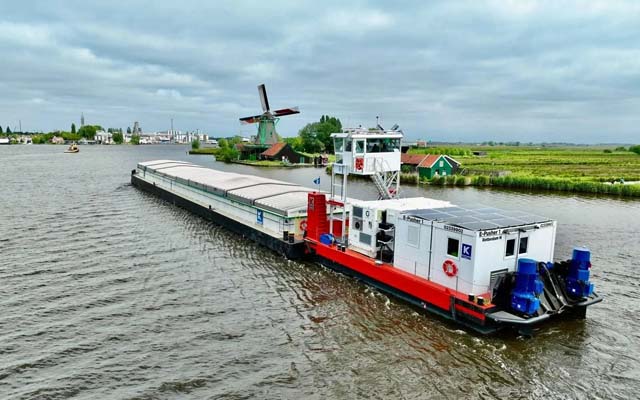Naval architect C-Job Naval Architects has been co-operating with shipbuilder Padmos and its client Kotug on the E-Pusher 1 project, which was originally launched by Kotug in 2021.
The E-Pusher 1 is the first fully electric pusher boat and barges, which will transport cocoa beans for Cargill between the port of Amsterdam and Cargill’s cocoa facilities in Zaandam.
The E-Pusher 1 has recently begun service. During the project, C-Job has worked onsite at Padmos, and assisted Kotug and Padmos in developing the concept design and the engineering of the basic and detail designs of the E-Pusher 1. C-Job’s naval architect Bas Crama assisted on the setup of the modular build and strength calculations of the steel frame and HDPE hull, and managed the building support and part of the commissioning of the vessel.
The E-Pusher concept is believed to be unique, as a fully electric and zero-emission pusher tug with a hull made of HDPE plastic. HDPE has many benefits, especially its recyclability, light weight and low maintenance nature. It is considered cost-effective, durable, and eco-friendly, while being weather and rot proof. The 20ft modular battery container on the vessel offers the ability to switch between various energy sources, from fossil, hybrid, and fully electric power to hydrogen, ensuring it is ready to switch to other sustainable energy sources in the future. Being completely electric, the E-Pusher travels silently, reducing noise in the busy port of Amsterdam.
C-Job’s collaboration with Stellendam-based shipyard Padmos dates back some eight years.
Padmos director Walter van Harberden said: “Our longstanding relationship with C-Job means that we work shoulder to shoulder with them. This groundbreaking design showcases how well C-Job and Padmos work together. With C-Job’s engineering skill and Padmos’ know-how, we make a brilliant team to efficiently build a vessel.”
Crama added: “It’s always a pleasure working together with Padmos as I know that we support each other in all aspects. Being involved in the engineering and also witnessing the build of the vessel at Padmos’ yard brought a great feeling of satisfaction at the end of the project.”
Because of the modular design, the construction process of the vessel took half the time of a traditional pusher. The E-Pusher 1 can push up to 4,000t of cargo and is expected to reduce CO2 emissions by 190,000 kg/yr, equivalent to about 15,000 truck journeys from the Port of Amsterdam to Cargill’s cocoa factory.



